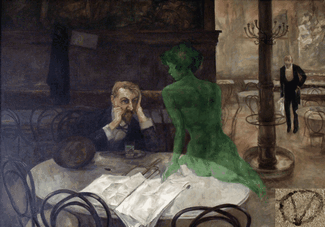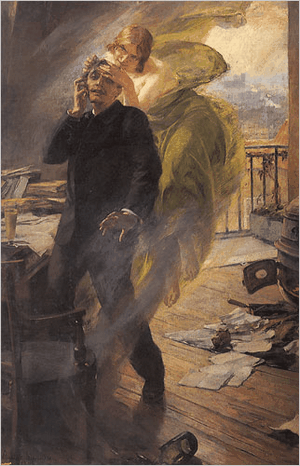If you thought Marijuana was the first green, natural intoxicant banned for it’s reported effects on the human mind, you would be wrong. Over a hundred years before marijuana was banned in 1937 in the U.S., Europe had an outbreak of it’s own form of ‘reefer madness’. It was a green, potent, alcoholic drink called ‘Absinthe’. Like marijuana, absinthe was embraced by artists of all types and the banning of absinthe was based not on facts, but on fear, mistrust and the objections of some who just could not stand the fact that others were having so much fun. Also, like marijuana, absinthe is not something anyone should consume carelessly since it can have a very potent effect on those who consume it.
Absinthe, known as the Green Fairy, or la Fée Verte in French, has long been veiled in mystery and myth. The liquor’s color is usually either a natural or artificial pale emerald green, and is why it became known as the Green Fairy. The natural green color is obtained by steeping, or maceration of, green anise, grande wormwood, and florence fennel in alcohol. It is then distilled, with a second maceration afterward; this causes the green hue. Other herbs may be used also, including hyssop, melissa, star anise and petite wormwood. Steeping the herbs produces chlorophyll, causing the green color. This drink has a high alcohol content, and may be another reason for the mysterious properties. The bitterness of absinthe comes from absinthine found in the wormwood. It is one of the most bitter substances known. Wormwood, used as a medicinal remedy for many years, is the ingredient that has caused the myths to abound.Historically, the use of wormwood for medicinal purposes can be traced to 1550 Egypt. The ancient Greeks were also known to use wormwood leaves soaked in wine. Legend has it that absinthe was created and used as a remedy by Dr. Pierre Ordinaire, a French doctor living in Switzerland, somewhere between 1789 and 1792. His version of wormwood and herbs such as green anise and fennel, soaked in alcohol, produced a bitter tasting 136 proof liquor. It is unsure whether it was Dr. Ordinaire’s recipe, or one of their own making, but the Henriod sisters eventually ended up with it. Later, a man by the name of Major Dubied bought the formula from the sisters. He and his son Marcellin, as well as his son-in-law Henry-Louis Pernod, opened Dubied Père et Fils, an absinthe distillery, in Couvet, Switzerland in 1797. In 1805, the newly named Maison Pernod Fils distillery, a larger factory, opened in Pontarlier, France.
Producing 30,000 liters per day at the height of production, the absinthe was distributed worldwide. The original recipe of the Pernod Fils distillery contained aromatic herbs such as wormwood, Roman wormwood, hyssop, lemon balm, fennel and anise. Later, other herbs were included such as angelica, dittany, juniper, nutmeg and star anise.
Absinthe became popular in the late 19th and early 20th centuries in France. Famous artists and writers romanticized the drink, including Oscar Wilde, Gauguin, Charles Baudelaire, Edgar Allen Poe, Toulouse-Lautrec and Ernest Hemingway. It was reputed to tap into the more creative side and considered a muse. Absinthe appears in works by Vincent Van Gogh and Pablo Picasso. At the end of the 19th century, absinthe was the spirit of choice – the cocktail hour being known as the green hour.
Eventually rumored to be an addictive, psychoactive drug, absinthe was banned in the United States, as well as many European countries by 1915. Jean Lanfray, a French farmer, shot his entire family in August of 1905. It was sensationally reported that he was under the influence of absinthe and although he had also consumed several other alcoholic beverages that day as well, this was left out of the report. This was one of several reports of violent crimes blamed on the influence of absinthe, and caused many countries to ban the drink. Between the years 1906 and 1915, the governments of Switzerland, Belgium, Brazil, the Netherlands, France, Australia and the United States had all banned it.
The United Kingdom never banned absinthe and was where the green liquor began to make a comeback. In 1990, BBH Spirits, an importer, realized it was legal to sell absinthe in the UK. A distillery in the Czech Republic began manufacturing Hill’s Absinthe around this time, which popularized the liquor once again.
Spain, Portugal and Mexico are among the countries that have never banned absinthe, and it has remained a popular drink there. In France, a law was passed in 1988 requiring that beverages that do not comply with the European Union regulations of thujone content (a chemical found in wormwood) or that are labeled ‘absinthe’, fall under the ban. Absinthe is made in France today for export to other countries. It is also sold in France, but labeled spiritueux à base de plantes d’absinthe, or ‘wormwood-based spirits’.
Absinthe is now legal to produce or sell in nearly every country that has legalized alcohol. The major exception to this is the United States; it is legal to possess or consume absinthe, but illegal to produce or distribute. Absinthe is available in a few establishments around the US, but finding which ones is difficult, and usually only found by word of mouth. Marijuana remains illegal due to a costly and misguided ‘war on drugs’. Both these natural, green intoxicates are potent, and it would be ill advised for people to partake of them without understanding that possible irrational thought and behavior may ensue. It is another form of irrational behavior to punish supposedly free people for even taking the risk to see if they enjoy something.



